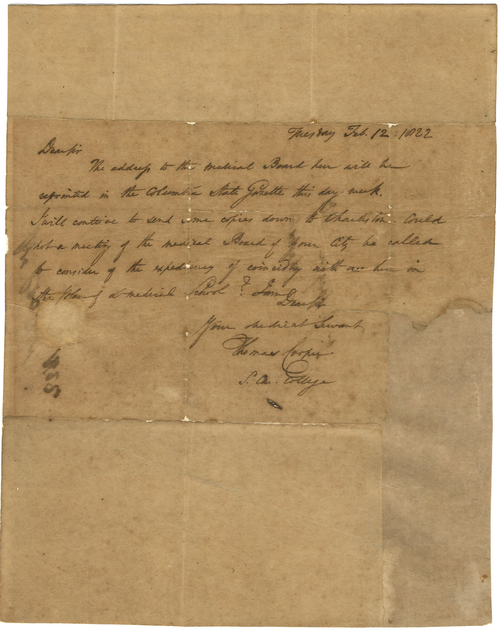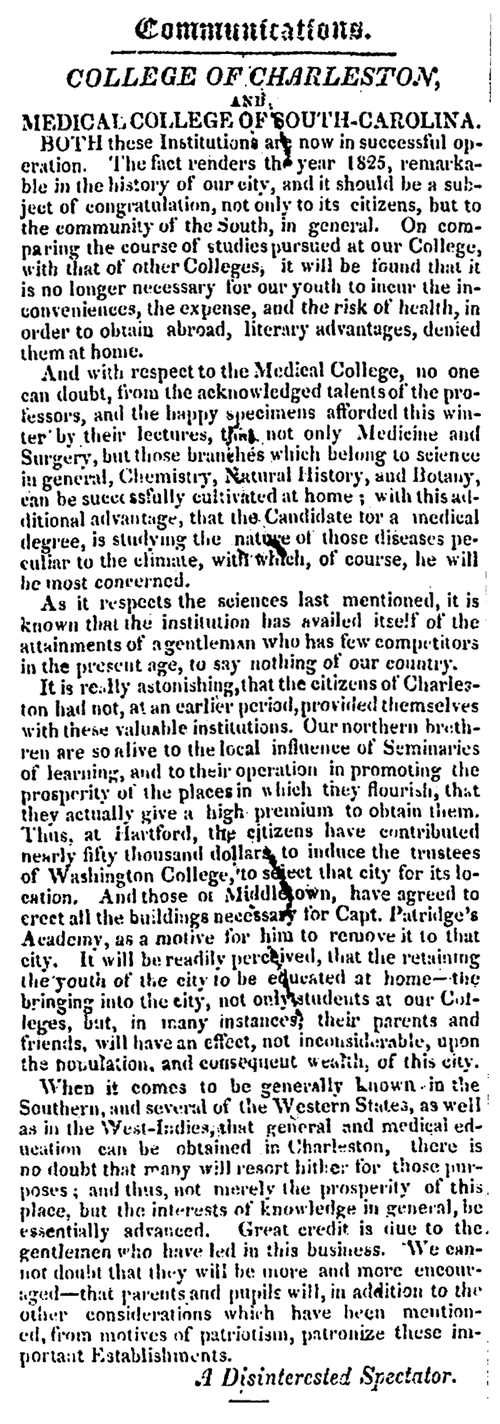Historical Context
<br/>
<br/>
A confluence of events and movements contributed to the urgency of founding a medical school in South Carolina in the early 1820s. While it was certainly a matter of local pride and there was a dearth of medical schools in the South, it is essential to remember that the men of the Medical Society were each, themselves, enslavers who—like so many Southern white men of the day—wanted to protect the institution from which they benefitted. Indeed, slavery was at once an economic, political, and sociocultural issue for South Carolinians by the time the Medical Society received a charter to establish a medical school from the state legislature at the end of 1823. The Medical College of South Carolina was ultimately founded for one reason: to preserve the institution of slavery by educating young medical minds at home—protected from the radical arguments of abolitionists—in order to treat local ailments and illnesses that plagued both white and black populations alike, thereby ensuring the survival of both enslavers and the enslaved.
<br/>
During the Panic of 1819, while cotton’s price plummeted and state banks began foreclosing on mortgaged properties, enslaved persons retained value. Their “natural increase”—the birth of healthy, enslaved children to sell at market to supplement the loss of income from cotton’s falling price—saved many a southern planter from financial ruin in ensuing years. To that end, professional medical treatment of enslaved men, women, and children across the state, and the South more broadly, was thus essential.

<br/>
The Missouri Compromise of 1820—although allowing the admittance of a slave state—established the precedence of Congressional regulation over slavery, angering many pro-slavery advocates. That same year, in response to what many viewed as an assault upon the Southern way of life, the state legislature and the City of Charleston tightened restrictions on free and enslaved blacks. Troubled by the growing population of free blacks and mixed race persons, the South Carolina state legislature outlawed private emancipation. The
only way an enslaved person could be emancipated was, in the words of one local historian, “to gain the sympathy of the majority of the conservative white men who formed the state’s General Assembly.” It also banned the movement of free blacks and persons of mixed race to pass through, visit, or move to South Carolina. Finally, and perhaps most importantly, the same act banned the importation and circulation of abolitionist literature. Indeed, the second wave of abolitionism, spurred on by the Second Great Awakening, was well underway in northern states, giving arguments against slavery a strong religious and moral component. These pamphlets and broadsides rolled off the presses of Philadelphia, New York, and Boston print shops, the very cities so many South Carolinian students journeyed to complete their medical educations.
<br/>
This fact did not go unnoticed by Dr. Thomas Cooper (1759-1839) of Columbia. In
an address given to the Medical Board of Columbia in 1821
, Cooper observed:
<br/>
"When the students go to Philadelphia and New York, they are apt to acquire a taste for a style of living, not suited to this country. The abundant markets, the tavern meetings, the theatrical entertainments, the concerts, the country excursions, and so forth, imbue them with notions unsuited to the habits of the south. Nor is it a trifling objection, that they are apt to acquire northern habits, propensities, prejudices and modes of thinking [emphasis added]: a false notion of northern pre-eminence, from receiving the finish of their education there; and an undue preferences for northern talents and attainments…"
<br/>
In short, medical students of the day were being exposed to dangerous beliefs and ideas, including anti-slavery sentiments, that were antithetical to the established Southern way of life. Cooper went on to say, “It is an
evil [emphasis added] … that [medical students] should be tempted to form habits and opinions unsuited to the country in which they are ultimately to live.” He also voiced another complaint: that Northern medical schools were tailored to the observation and treatment of diseases endemic to Northern climates. This he considered another evil, “that they should have small chance comparatively, of studying the forms of sickness peculiar to their own country, and the intended seat of their future practice.” Although Cooper ultimately hoped to establish a medical school in Columbia, it was this very address that inspired Charlestonians Samuel Henry Dickson and James Moultrie, Jr., prompting them to pursue the establishment of a state medical college in earnest.

<br/>
Finally, the Denmark Vesey plotted rebellion in the summer of 1822 sent shockwaves through the city of Charleston and the South more broadly. Among the uprising’s leaders were free blacks as well as trusted, urban domestic slaves, many of whom had been born and raised locally, taught to read and write, had more freedom of movement and relatively better living conditions than most of the enslaved population. Vesey, himself formerly enslaved until winning a lottery and purchasing his freedom in 1800, devoured abolitionist literature. Motivated by these sentiments and an admiration for the Haitian Revolution of 1791, he organized a violent revolt. Thousands of the Lowcountry’s enslaved and free black populations plotted to come together to seize the city of Charleston and execute their enslavers. Before they could do so, however, the conspiracy was exposed. Although Vesey and his co-conspirators were ultimately rounded up before putting their plan into effect and executed the morning of July 2, 1822, the incident threw into sharp relief what South Carolina’s black majority was capable of. It became more important than ever to protect the institution of slavery and white supremacy.
<br/>
Taken together, these political, cultural, and economic events and intellectual arguments informed the founding of the Medical College of South Carolina at both levels of the Medical Society and the General Assembly. This is made plain in an article from “A Disinterested Spectator,” published in the
Charleston Courier
in January 1825, two months into the inaugural academic year. The author praised the Medical College for successfully cultivating a course of study that rivaled contemporary Northern schools and, most importantly, taught students how to treat “those diseases peculiar to the [Southern] climate.” Furthermore, he believed:
<br/>
"When it comes to be generally known in the Southern, and several of the Western States, as well as in the West-Indies, that … medical education can be obtained in Charleston, there is no doubt that many will resort hither for those purposes; and thus, not merely the prosperity of this place, but the interests of knowledge in general, be essentially advanced. Great credit is due to the gentlemen who have led in this business. We cannot doubt that they will be more and more encouraged—that parents and pupils will, in addition to the other considerations which have been mentioned, from motives of patriotism, patronize these important Establishments."
<br/>
The places where the author imagined students would come from is particularly revealing of the school’s larger purpose. The Medical College was not only attractive to South Carolinians or those prospective students in neighboring Georgia and North Carolina. It instead had a broader appeal: to the Southern slave states, drawing students from as far west as Alabama, Mississippi, Louisiana, and Missouri, and even east from the Caribbean. Indeed, the mention of British colonies is reflective of the shared concern between American Southerners and British West Indian slaveowners regarding abolitionist sentiment at the time. Indeed, throughout the 1820s in Britain—as in the United States—colonial abolitionism was hotly debated. The “motives of patriotism” that the author alludes to might thus be better understood as a desire to study under and with those who share the same political, economic, and cultural sentiments.
<br/>
All of this is not meant to diminish the intellectual and professional accomplishments of the men who founded the Medical College of South Carolina and the doctors it produced in its early years; merely, it is an effort to situate them within their own historical context and the realities of the political, economic, and social milieu that led to the school’s founding.
<br/>
(Image Description [1]: Handwritten letter by Thomas Cooper dated February 12, 1822. Waring Historical Library, Manuscript Collection, MSS 8.)
<br/>
(Image Description [2]: Newspaper article discussing the Medical College's opening from an anonymous individual. “Communications College of Charleston, and Medical College of South Carolina.”
Charleston Courier. January 15, 1825.")


